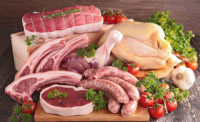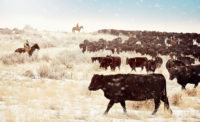If increased market volatility is the new normal in agriculture markets, then 2014 proved that processors are comfortable rolling with the punches.
Processors are becoming quicker at accepting the curveballs thrown at them — such as animal diseases, drought, decreased production supply and international politics — and adjusting. And those curveballs come from a variety of locations in today’s global marketplace.
“Whatever happens in Beijing this morning is going to impact corn prices in Iowa,” for example, notes Mark McCully, vice president of production, Certified Angus Beef, Wooster, Ohio. However, with consumer confidence returning to pre-recession levels, processors are finding that despite rising prices due to decreased supply, demand is remaining steady or even increasing for 2015.
“In general, 2014 has been a good year for the livestock industry due to a significant cheapening of feed ingredients and strong demand, despite any challenges,” says Derrell Peel, extension livestock marketing specialist, Oklahoma State University, Stillwater, Okla.
Moreover, exports continue to grow for all segments of the industry, with beef at 10 percent to 12 percent (at pre-BSE scare levels), poultry at 15 percent and pork at 20 percent, notes Ben Parks, risk management consultant, INTL FCStone, Kansas City, Mo.
But the export market comes with its own risks.
“Exports are a blessing because of the huge consumer demand, but a curse because they are volatile and unpredictable,” says Parks. “They are dependent on factors out of our control, such as currency rates and the mercy of public perception and politics, most notably Russia, which shut off protein imports after international sanctions.”
Record prices, steady demand
In general, the beef industry has extremely tight supplies — in fact, the industry is at a 60-year low in cow numbers, says Peel.
And due to cows’ lengthy breeding cycle and growth (18 months to 24 months), beef supply is predicted to be tighter for the next 12 months, if not 24 months, notes Parks.
“Production is down 5 percent compared to 2013, and is expected to be down 3 percent for next year,” says Parks. “Carcass weights are up, but they can’t make up the difference in lower head counts.”
So consequently every beef category has shown record prices due to decreased supply, which is positive as long as consumer demand holds.
“Domestic consumption is down but due to less supply,” says Parks. “Consumers are still willing to buy beef. In fact, consumer sentiment toward beef is in much better shape — dating back to 2008/2009 levels, even.”
How will retail markets respond to ever higher prices?
“Beef is moving through the system at really good prices, and that’s an indication in and of itself for strong demand,” says John Lundeen, executive director of market research for the National Cattleman’s Beef Association.
Staying ahead of diseases
For the last 18 months, the pork industry has also struggled with supply, due to the porcine epidemic diarrhea virus (PEDv), which has proven fatal to baby pigs. Indeed, roughly 50 percent of hog operators have been affected, notes Peel.
But due to quicker and bigger litter rates, hog producers can ramp up production faster than beef. Pork slaughter is down 5 percent, but production is only down 2 percent, says Peel.
“And we’re likely to see increased production in 2015 due to expected profitability — perhaps a 4 percent increase in production with 2 percent due to exports,” says Peel.
Since PEDv flourishes in cold weather, hog farmers should start seeing its effects soon. However, the hope is that better biosecurity measures and new vaccines (the effectiveness of which is yet to be known) will produce results that aren’t as bad this year, says Parks. In addition, growing international demand for pork should only continue, explains Liang Feng, an analyst with Chicago-based Morningstar.
“Pork producers are smarter at dividing up the supply to make use of portions that are not as popular in the U.S., but are better received in other countries,” says Feng. As U.S. consumers look for a less pricey alternative to beef, they are happy to try pork options.
“We’ve actually seen demand be very strong this year, and even with higher prices, we have seen an increase in consumers’ willingness to pay for pork,” says John Green, director of strategic marketing for the National Pork Board.
Improving margins
Since the Great Recession, chicken processors have faced tough times, notes Feng. Pilgrim’s Pride, for one, filed for bankruptcy protection (and emerged under ownership by Brazilian processor JBS), and marginal producers struggled or left the market because of increased commodity costs and decreased demand. Droughts have forced feed prices up, as well.
“Now we are seeing firms benefit from increased prices,” says Feng. “Poultry processors are committed to grow supply, so they can offer a better price to consumers.”
The poultry industry experienced decent returns in 2014, says Peel.
“The data shows they are ramping up production, maybe by 2 percent,” he says. “Prices are good and feed costs are cheaper.”
Indeed, the U.S. Department of Agriculture estimates the total chicken consumption for 2014 at 83.5 pounds per person, which is an increase of 2.5 pounds per person since 2009. In comparison, the other proteins clocked in at 53.8 pounds for beef, 45.9 for pork and 15.6 for turkey. Why has chicken consumption been down since 2006?
“A few reasons: modest production increases due to the strain on the corn market caused by ethanol production and the 2006 Renewable Fuels Standard; growth in the U.S. population; people eating out less because of the recession of 2007-2009; and increased poultry exports,” says Tom Super, vice president of communications, National Chicken Council.
Turkey’s per capita consumption has remained relatively flat, but its share of consumers’ dollar is up and exports have risen to 10 percent to 15 percent, says Joel Brandenberger, president, National Turkey Federation.
Looking ahead
Poultry and pork both look to be in expansion mode through 2015.
“Beef, however, is in contraction, so it still will have a tough time ahead,” until supply rebounds in 2016, notes Parks.
Yet this rebuilding time can be viewed as an opportunity.
“While 2015 may be a slow down, it’s not a breakdown,” says Jim Chappelow, an economist at ITR Economics, Boscawen, N.H. “Companies should have equity and people in place to take advantage of the accelerated economy in 2016 and 2017.”












Report Abusive Comment